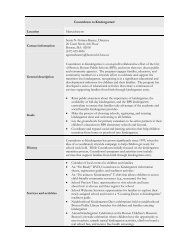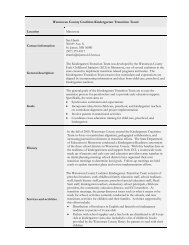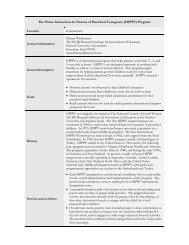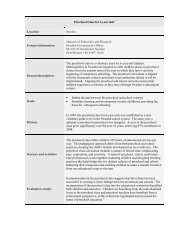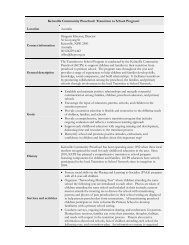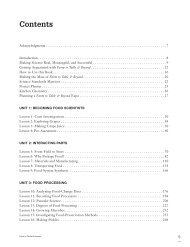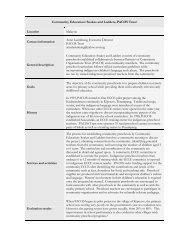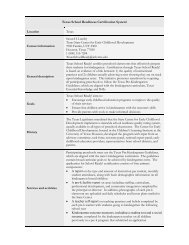Proceedings of the Fourth Annual Teachers College Educational ...
Proceedings of the Fourth Annual Teachers College Educational ...
Proceedings of the Fourth Annual Teachers College Educational ...
Create successful ePaper yourself
Turn your PDF publications into a flip-book with our unique Google optimized e-Paper software.
A variety <strong>of</strong> data sources were collected to act as evidence within this research study. To provide<br />
context, <strong>the</strong> researchers had worked previously in a pr<strong>of</strong>essional development setting over <strong>the</strong> past<br />
calendar year.<br />
After successfully working toge<strong>the</strong>r on an initial research project, <strong>the</strong> participating teachers suggested<br />
that <strong>the</strong>y wanted to build on previous research where <strong>the</strong> researchers had previously video recorded <strong>the</strong>ir<br />
lessons while visiting <strong>the</strong> classroom to recording <strong>the</strong>ir own instruction <strong>the</strong>mselves. The CTT teachers<br />
video recorded <strong>the</strong>ir instruction in a documentary-style manner where <strong>the</strong>y included <strong>the</strong>ir instruction as<br />
well as any interactions that occurred within <strong>the</strong> classroom. The footage was screened with <strong>the</strong> video<br />
being examined in terms <strong>of</strong> analyzing and reflecting on <strong>the</strong> quality <strong>of</strong> <strong>the</strong> classroom instruction. The<br />
teachers <strong>the</strong>n commented on <strong>the</strong> video in a written form using guiding questions suggested by <strong>the</strong><br />
researchers that would narrow <strong>the</strong> analysis to a more manageable frame.<br />
To ensure that <strong>the</strong> data collected was accurate, valid and reliable, <strong>the</strong> researchers visited <strong>the</strong> classroom<br />
and assisted students to become a more seamless part <strong>of</strong> <strong>the</strong> classroom culture not only within Science,<br />
but across subject matter. This helped <strong>the</strong> researchers develop thick and rich descriptions <strong>of</strong> this<br />
particular classroom culture. To help corroborate <strong>the</strong>se findings, <strong>the</strong> classroom teachers revisited <strong>the</strong><br />
substance <strong>of</strong> <strong>the</strong> classroom lessons by watching video from instruction. In this instance, by having<br />
teachers re-examine personally shot footage, it helps <strong>the</strong>m to develop <strong>the</strong>ir own ideas about <strong>the</strong>ir<br />
classroom practice.<br />
The subject matter <strong>of</strong> <strong>the</strong> lessons focused on school board-created curriculum standards in 2nd Grade<br />
Science. In addition to <strong>the</strong> video recording, additional student-generated data included notebooks,<br />
drawings and personal testimonials to <strong>the</strong> camera that were inspired by teacher questioning as well as<br />
<strong>the</strong>ir own improvised oral utterances. The notebooks and drawings were requested by <strong>the</strong> classroom<br />
teachers to corroborate <strong>the</strong> students’ in-class observations.<br />
Scholarly significance <strong>of</strong> <strong>the</strong> study<br />
There are simply too few science teachers across <strong>the</strong> US (Ingersoll, 1999). In an increasingly globalized<br />
economy that puts a premium on information processing, we need to fully teach <strong>the</strong> knowledge-base and<br />
skills inherent to science education through our Science curriculum. By utilizing existing technology tools<br />
that allow educators to more effectively use <strong>the</strong> communicative and social aspects <strong>of</strong> digital media<br />
production, we have a better chance <strong>of</strong> improving in-service teacher pr<strong>of</strong>essional development in both<br />
scientific subjects as well as student Science learning. By implementing and investigating teacher-video<br />
recorded action research regarding <strong>the</strong>ir classroom teaching within <strong>the</strong> practical surroundings <strong>of</strong> a 2nd<br />
grade Science class, we have <strong>the</strong> potential to improve teacher pr<strong>of</strong>essional development in Science<br />
education and <strong>the</strong> learning experience <strong>of</strong> students. There are many affordances with respect to video<br />
recording technologies, such as asynchronous screening <strong>of</strong> classroom instruction, which actively<br />
incorporate visual and aural elements <strong>of</strong> in-class instruction. These hold promise for improved Science<br />
education as well as its impact on students.<br />
References<br />
Ingersoll, R.M. (1999). Turnover and shortages among science and ma<strong>the</strong>matics teachers in <strong>the</strong><br />
United States. Science Teacher Retention: Mentoring and Renewal. Issues in Science Education,<br />
SE 066 056.<br />
70



